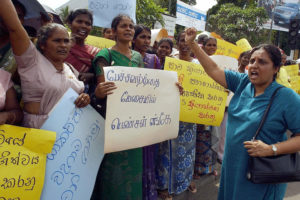FP: As the mothers’ van headed deep into Tamil Tiger territory, it was suddenly encircled by young boys in sarongs with automatic weapons. But the five women inside it had sent missives ahead through the Catholic Church, using carefully crafted language to signal their neutrality. Unlike the representatives of the Sri Lankan state, they weren’t perceived as having blood on their hands. The child soldiers escorted them deeper into the jungle, without harming them.

Sri Lankan women gather to demand peace talks between the government and Tamil Tiger rebels in Colombo on Dec. 10, 2004. (Sena Vidanagama/AFP/Getty Images)
That was how Visaka Dharmadasa, the mother of a Sri Lankan Army soldier declared missing in action, found herself sitting opposite a local Tamil Tiger commander on the dirt floor of a Christian shrine in northwestern Sri Lanka in December 2000. Together with four other mothers of missing soldiers, Dharmadasa had dared to cross the heavily mined no man’s land between Sri Lankan government-held territory and Tamil Tiger-held territory to search for news of their sons and demand an end to the conflict.
In recent decades, a growing body of research has shown that when women’s groups are able to meaningfully influence peace processes, the resulting agreements are stronger and more likely to last.
As a result, inclusive peace processes have gained traction internationally. Women made up over 30 percent of the negotiators of the 2016 Colombian peace agreement with the Revolutionary Armed Forces of Colombia (FARC), which was also the first peace process to include a Gender Subcommission. They participated at similar rates in the negotiation of the 2014 peace agreement between the Philippines government and the Moro Islamic Liberation Front, where they helped push for the inclusion of women’s civil society groups and gender provisions.
Cease-fires, however, remain the stubborn exception. They are often seen as standalone elements that deal mostly with military technicalities, so mediators may not find the inclusion of women’s groups particularly relevant at this early stage of a peace process. But new research from Inclusive Security reveals that from bringing warring parties to the peace table to defining the terms of the cease-fire and monitoring its implementation, women’s groups can help transform these fragile, tenuous agreements into more comprehensive, lasting peace processes.
In a study of 40 peace processes since the Cold War, researchers noted four reoccurring actions, the first being the frequency with which women mobilized to pressure warring parties into reaching a cease-fire. The second was the tendency of women’s groups to pressure parties to remain at the peace table until they reached an agreement. In none of the 40 cases did women’s groups organize against peace; in fact, they mobilized in favor of it more than any other group.
Women have also expanded the lists of hostilities covered by cease-fires. In Burundi, mediators consulted a group of civil society representatives—many of whom were women—in parallel to the formal cease-fire talks. The group brought to light violent acts the armed parties had kept silent about, helping the mediators advance a more comprehensive ban on hostilities. In addition to troop movements and supplies of ammunitions, the final agreement forbade “all acts of violence against the civilian population – summary executions, torture, harassment, detention and persecution of civilians … incitement of ethnic hatred, arming of civilians, use of child soldiers.”
This is significant. Cease-fire monitoring and verification missions base their mandates on such lists, meaning they heavily influence what will be counted as a cease-fire violation and what types of dispute mechanisms will be needed to prevent re-escalation. The more holistically cease-fire agreements reflect the realities of citizens, not just those the combatants wish to acknowledge, the harder it becomes for the latter to claim adherence to the agreement as they continue to attack, torture, and rape members of one another’s communities.
Most cease-fire agreements also require monitors to consult with local populations. As 21st-century warfare decentralizes, moving away from battlefields and into cities and villages, the truth on the ground locally takes on new urgency. Yet widespread instability makes it difficult for international monitors to access such areas. That’s why in Mindanao, the Philippines, Mary Ann Arnado formed an entirely volunteer civilian monitoring group called Bantay Ceasefire.
Arnado realized early on that all-female units would increase the organization’s ability to engage with women and sensitize male counterparts to the different impacts of war on men, women, boys, and girls. Their establishment not only led to a significant increase in reporting, but Gen. Ariel Bernardo, the former chair of the Government Cease-fire Committee, reflected that “our soldiers are now more afraid to commit any violation against civilians because of the women monitors who are constantly watching.” The group’s domestic legitimacy and reliable reporting of violations on all sides quickly won it an invitation to join the official International Monitoring Team.
But in places like South Sudan, entirely male, international, military monitoring and verification teams struggled to recruit South Sudanese community liaisons from their perch in Juba. In part because it was particularly dangerous and taboo for South Sudanese women to deploy with a foreign, male force, the teams were left with an entirely military and male perspective that resulted in a heavy focus on military action and a lack of attention to civilian protection and humanitarian concerns. The teams were better equipped to engage with armed actors than with conflict-affected civilians, particularly women.

